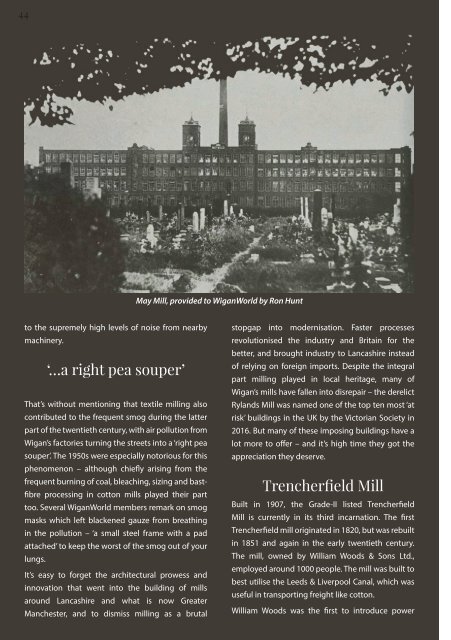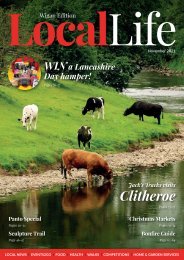Local Life - Wigan - March 2019
Wigan's FREE local lifestyle magazine.
Wigan's FREE local lifestyle magazine.
You also want an ePaper? Increase the reach of your titles
YUMPU automatically turns print PDFs into web optimized ePapers that Google loves.
44<br />
May Mill, provided to <strong>Wigan</strong>World by Ron Hunt<br />
to the supremely high levels of noise from nearby<br />
machinery.<br />
‘…a right pea souper’<br />
That’s without mentioning that textile milling also<br />
contributed to the frequent smog during the latter<br />
part of the twentieth century, with air pollution from<br />
<strong>Wigan</strong>’s factories turning the streets into a ‘right pea<br />
souper’. The 1950s were especially notorious for this<br />
phenomenon – although chiefly arising from the<br />
frequent burning of coal, bleaching, sizing and bastfibre<br />
processing in cotton mills played their part<br />
too. Several <strong>Wigan</strong>World members remark on smog<br />
masks which left blackened gauze from breathing<br />
in the pollution – ‘a small steel frame with a pad<br />
attached’ to keep the worst of the smog out of your<br />
lungs.<br />
It’s easy to forget the architectural prowess and<br />
innovation that went into the building of mills<br />
around Lancashire and what is now Greater<br />
Manchester, and to dismiss milling as a brutal<br />
stopgap into modernisation. Faster processes<br />
revolutionised the industry and Britain for the<br />
better, and brought industry to Lancashire instead<br />
of relying on foreign imports. Despite the integral<br />
part milling played in local heritage, many of<br />
<strong>Wigan</strong>’s mills have fallen into disrepair – the derelict<br />
Rylands Mill was named one of the top ten most ‘at<br />
risk’ buildings in the UK by the Victorian Society in<br />
2016. But many of these imposing buildings have a<br />
lot more to offer – and it’s high time they got the<br />
appreciation they deserve.<br />
Trencherfield Mill<br />
Built in 1907, the Grade-II listed Trencherfield<br />
Mill is currently in its third incarnation. The first<br />
Trencherfield mill originated in 1820, but was rebuilt<br />
in 1851 and again in the early twentieth century.<br />
The mill, owned by William Woods & Sons Ltd.,<br />
employed around 1000 people. The mill was built to<br />
best utilise the Leeds & Liverpool Canal, which was<br />
useful in transporting freight like cotton.<br />
William Woods was the first to introduce power


















